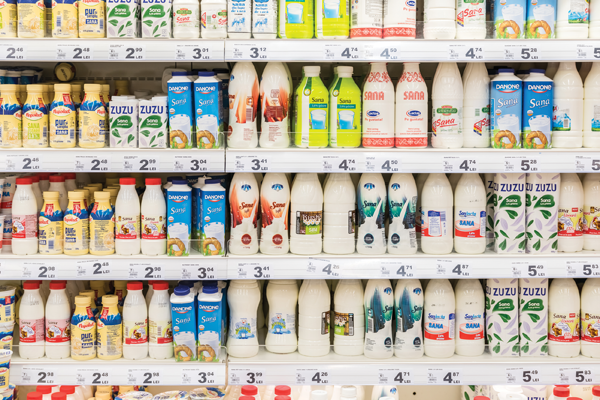What’s the difference between milk allergy and lactose intolerance?
- Like
- Digg
- Del
- Tumblr
- VKontakte
- Buffer
- Love This
- Odnoklassniki
- Meneame
- Blogger
- Amazon
- Yahoo Mail
- Gmail
- AOL
- Newsvine
- HackerNews
- Evernote
- MySpace
- Mail.ru
- Viadeo
- Line
- Comments
- Yummly
- SMS
- Viber
- Telegram
- Subscribe
- Skype
- Facebook Messenger
- Kakao
- LiveJournal
- Yammer
- Edgar
- Fintel
- Mix
- Instapaper
- Copy Link
Posted: 30 March 2021 | Neha Thakur, Vandana Chaudhary | No comments yet
Most allergen data is recorded via self-reporting, which is often inaccurate as many people confuse intolerances with allergies.


Progressive changes in our eating habits have activated significant changes in our quality of life. Readily available, calorific food has made us more prone to conditions such as obesity, diabetes and hypertension, to name a few.
At the same time, we are seeing an increase in food allergies – both in the sense of rate and the range of foods people are allergic to. There are several theories as to why these numbers are on the rise, including the accuracy of self-reporting. Presently, most of the data we use is based on this form of collation, with three to four times as many people believing they have a food allergy than is actually the case.1
Dairy-based foods are considered part of a healthy diet, as they offer good sources of calcium and vitamin D, as well as protein and other essential nutrients. But there is anecdotal evidence of confusion between lactose intolerance and milk allergy among both patients and physicians, which could result in unnecessary dietary restriction or avoidable reactions.
Terminology such as suspected milk allergy, milk intolerance and lactose intolerance are often used without a clear sense of their different meanings, an understanding of the varying mechanisms that trigger them, or the dietary implications of such diagnoses.
Milk allergy
Milk allergy is one of most common allergies, especially in children. This allergy occurs when the body’s immune system reacts to milk protein.
The allergic reaction may vary from mild (rashes, hives, itching, swelling, etc) to severe (trouble breathing, wheezing, loss of consciousness, etc). It usually starts before the age of one and most of the children outgrow it by age three, although this is not always the case.
Symptoms of milk allergy include:
Skin –
Red rashes, itches and swelling
Respiratory passage/mouth –
Trouble breathing or swallowing
Running nose accompanied with coughing
Itching, swollen lips
Digestion –
Nausea, vomiting
Diarrhoea, cramps
Anaphylaxis –
Acute allergic reaction, which can be lethal.
Lactose intolerance
Lactose is the predominant sugar in mammalian milk. Intestinal absorption of lactose requires hydrolysis of disaccharides to its component monosaccharides D-glucose and D-galactose, both of which are rapidly transported across the small bowel mucosa (see figure here).
Most infants have sufficient levels of lactase to digest almost one litre of breast milk. The lactase enzyme is naturally produced by the cells that line the small intestine; it is also produced by the bacteria that live in the small intestine. However, sometimes after weaning, a genetically programmed reduction in synthesis of lactase (resulting in very low lactase activity) can lead to lactase non-persistence (the inability to digest lactose).
The breaking down of the lactose produces glucose and galactose, which can be absorbed by the small intestine. If this happens quickly, only a small amount of lactose, if any, enters the large intestine (colon).2 However, if large amounts enter the colon, that individual may experience symptoms of abdominal cramps, bloating, excess flatulence, vomiting and loose stools or diarrhoea.
Symptoms of lactose intolerance usually manifest from 30 minutes to two hours after ingestion of milk-containing (dairy) products.
Lactose intolerance can be diagnosed by performing the following medical tests:
Stool acidity test
This test is often used to diagnose infants and children. A stool sample is taken to identify whether lactose is hydrolysed to simple sugars. Fermentation of lactose in the intestine will lead to the formation of lactic acid, which decreases the pH of stools.
Hydrogen breath test
This is the most commonly used test, whereby the hydrogen content of the individual’s breath is measured after consumption of a drink containing lactose. An increase in the level of hydrogen indicates that the body is not able to digest or absorb lactose properly.
Blood test
In this test, the individual is made to consume liquid containing lactose, after which time blood samples are taken every two hours to check the blood glucose levels. If there is no hike in glucose levels, it suggests the individual is intolerant.
Conclusion
Both milk allergy and lactose intolerance are manageable conditions with slight diet modifications.
There is evidence to suggest that breastfeeding can reduce the risk of allergies3 but it should be acknowledged that it’s not always possible for women to breastfeed.
There are a number of alternatives available for individuals with milk allergy; hypoallergic formulas containing hydrolysed proteins are safe to consume and least likely to cause an allergic reaction. Soy-based formulas are also an alternative, but the drawback is that soy itself is also an allergen.
Lactose can be managed by dietary modification and lactase enzyme supplementation. These products are available in many grocery stores and are just as healthy as regular milk and milk products. Alternative sources of milk nutrients like calcium, vitamin A, etc, include fish, broccoli and leafy greens, oranges, almonds, Brazil nuts, dried beans, tofu and products with labels that show they have added calcium.
About the authors
Vandana Chaudhary is Assistant Professor, College of Dairy Science and Technology, LUVAS, Hisar.
Neha Thakur is Assistant Professor, Department of Livestock Products Technology, LUVAS, Hisar.
References
- ncbi.nlm.nih.gov/pmc/articles/PMC6163515/
- ncbi.nlm.nih.gov/books/NBK310263/#:~:text=If%20that%20happens%20quickly%20and,the%20large%20intestine%20(colon).&text=But%20if%20large%20amounts%20of,passes%20into%20the%20large%20intestine.









